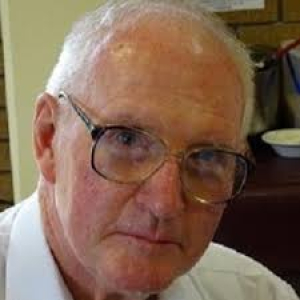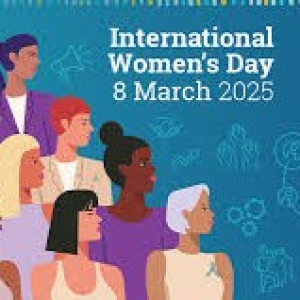Peter MALONE
Neds
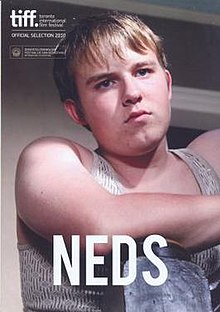
NEDS
UK, 2010, 124 minutes, Colour.
Conor McCarron, Greg Forrest, Joe Szula, Mhairi Anderson, Gary Milligan, Gary Lewis.
Directed by Peter Mullan.
Peter Mullan has had many decades strong career as an actor, in his native Scotland, and around the world, a distinctive screen presence. Great success with The maudlin Sisters and then Neds. Ned is one several Scottish BAFTA awards for best film and director.
The setting is Glasgow, 1970. The title refers to Non—Educated Delinquents, Needs. The film focuses on a young boy, John McGill (Greg Forrest) who is finishing in primary school with some success at his graduation, happy family, encouraging and visiting from America that he become a journalist, he very bookish and intelligent boy. However, there is a shadow with his older brother who is a delinquent with a bad reputation.
Then there is the drama of the transition from primary school to secondary school, the system of allotting students to classes, John feeling that he is in the wrong class, some brutal treatment from teachers, ridicule, and the shadow of his our brothers reputation. The father at home is alcoholic, brutal and shouting. The mother’s long-suffering. With a particular bully, John gets the help of his brother and the gang brutalising as John watches. A sign of things to come.
The main part of the film has John in his mid teens, played ball by, McCarron, still bookish, but becoming more defiant, caught up in the activity of the students, defying teachers in class, gradually a transition to becoming part of delinquent gangs, involved in fights and brutality.
Perhaps the film could have ended there as a moral warning. However, Peter Mullan screenplay continues with an opportunity for John to come to some kind of awareness of what has happened to him, making an option for a transition, a change of heart, a change of behaviour, and some prospects for the future.
For a Scottish audience, the Glasco accent is not a problem – but, for those outside Glasco, often very difficult to hear and understand, the need for a reliance on subtitles.
- The title, an abbreviation for non-Educated Delinquents?
- The Scottish atmosphere, the city of Glasgow, the neighbourhood, homes, streets, parks, school, gangs and thugs? The accent – and difficulties for audiences without some subtitled help? The musical score? The music and songs of the 1970s, atmosphere?
- The story of John McGill, Glasgow 1970, at primary school, the end of year and his awards, family, his aunt from the US and her encouraging him to journalism, at home, the alcoholic father and his solemn behaviour and shouting, his mother and her care, the older brother and his being a delinquent, the treatment of John at school, the new school, the bullying, Kanter, John going to his brother, the taking of Kanter and the brutality as John watched? The ambiguity for his character, keen reading, book 1, clever, in class, the role of the teachers and getting him to answer? But the bullies and the mockery?
- The new school, the allotting of classes, his being put in the wrong class, the behaviour of the teachers, the strap, severity, John going to the principal, a hangover from his brother’s bad behaviour, in the class? The effect on him?
- The moments of background of religion, the church, the communion sequence?
- John, older, the years passing, his love of learning? But the pressure, the bullying, his change of attitude, the defying of the teachers? His behaviour with the other students, the boys, interactions with the girls?
- Audience response to his change of character, moving with the boys, the pictures of the gangs, the interactions, the gangs respect for his brother, his confrontation with the earlier bully, Kanter? The scenes of the gangs, on the bridge, the fights?
- The consequences for John, change of character, his aunt’s visit and her surprise? His relationship with his mother?
- A surly teenager, moments of brutality and violence, the breaking down of his ideals?
- The confrontation, the motivation for his change of heart, the possibility for some kind of personal conversion, his taking action, improvement and development – and some hope for the future?
i"m Still Here
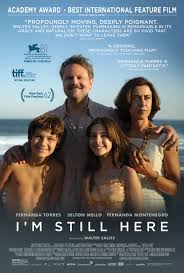
I’M STILL HERE
Brazil, 2024, 113 minutes, Colour.
Fernanda Torres, Selton Mello, Antonio Saboia, Fernanda Montenegro.
Directed by Walter Salles.
A drama that is well recommended. Nominated for many awards, it would it won the Academy Award for Best Foreign Language Film, 2024, was nominated in a number of categories. The star, Fernanda Torres, won a Golden Globe for Best Actress. The film has had 60 nominations for awards and 50 wins.
The director is Walter Salles, one of Brazil’s eminent directors, celebrated in the 1990s with international acclaim for Central Station. Director of many Brazilian films, he had international attention with his story of Che Guevara, The Motorcycle Diaries, and the thriller, Dark Waters, with Jennifer Connolly. His career is a fine cinema achievement.
In this film he is very much on home ground, Brazil in the 1970s, experiencing the military dictatorship – and a reminder that during the 1970s there was the turmoil in Chile, Allende and Pinochet, and the violent rule of the generals in Argentina.
The film opens joyfully, sunny, the beach, the water, happy family, the father a politician returned from exile, his strong-minded and loving wife, four daughters and a young son. It seems idyllic. But, an indication of difficulties to come, a group of youngsters are pulled over by the police, roughly treated, under suspicion, but let go. Despite the happy home sequences, the gatherings of friends, the zest for life, these are intimations of trouble to come.
The father, Rubens Paiva(Selton Mello) is genial, but suggestions that he is also involved in something subversive. But, the principal focus of the film is on his wife, Eunice, a powerful presence, an admirable performance by Fernanda Torres.
Heavy-handed officials take the husband away, and his wife is interned in a prison, echoes of torture and interrogations resounding in the darkness. One of the daughters is also taken. Because so much of Rio is seen in sunlight, the dark prison, the conditions, the harsh treatment, although one young guard is sympathetic and offers some information and support, the continued sense of menace, set the tone for the rest of the film.
Eunice pursues the search for her husband, supported by her family and friends, discovers the network of support for victims of the government. Eunice also decides, especially with police and government thugs continually parked outside the home, to take the family to San Paolo, wrenching sequence as the house is emptied and they drive away from the past.
Then a transition to the 21st century, Eunice having gone back for studies, heavily involved in legal issues and citizens rights, supported by the family and their families, especially the son, Marcelo, on whose book about his father this film is based. Here is a woman who started life with ordinary expectations, has suffered severely, has created a new life and career with significant public achievement.
Amid the joy, there is a sad aftermath, as Eunice has succumbed for years to dementia – and Walter Salles casting his award-winning star from Central Station, Fernanda Montenegro, as the elderly Eunice. And, as might be expected, there are photos of the actual characters during the final credits, tribute to them.
The experience of repression and suppression is destructive – but, it can also be a challenge to work for a better world.
- The status of the director, nominations and awards?
- Impact for a Brazilian audience? For audiences outside Brazil? Brazil’s history, military dictatorship, the 1970s?
- The Rio setting, the sea, the beaches, the mountains, buildings, streets, homes?&, Sells? The transition to San Paolo? The 21st-century, political activity, homes, reunions? The songs and musical score?
- The happy beginning, the sun, the water, swimming, the beach, the family, happy scenes at home? Rubens, his past career, on the left, exile and returned, his activities, keeping in touch with families of exiled letterwriters? Eunice, cheerful, in the house, her children, the oldest daughter and her studies, going to England? The older daughters? The children, Marcella and his vitality? The range of friends, dinners, meetings?
- The youngsters in the car, pulled over by the police, suspects, the rough treatment? Indication of themes to come?
- The intrusion into the house, the taking of Rubens? The taking of Eunice, of
- ear? The prison, the cells, dark, squalor? Eunice, the bewilderment, the interrogations, the fierceness of the interrogators? Some support from the sympathetic guard? The daughter, interrogation, about home? The books are photos, Eunice and her going over them, identification, her quest for her husband, her being let go?
- The aftermath of the arrest, the agents in the parked car outside the house, Eunice going out to confront them and their driving away? The contact with her friends, trying to get information, trying to get money from the bank and the need for her husband’s signature, gradual Revelation about the network for helping exiles? The support of friends, inability to help?
- The decision to leave Rio, to go to San Paolo, the reaction of the daughters, Marcella, the emptying of the house? Driving away?
- The strong characterisation of Eunice, in these situations? The portrait of the daughters, Varo and her going to London, communications, her return? The other daughters, is Lani and not wanting to leave Rio, the young children?
- The passing of time, Eunice and her going back to study, her achievements, political involvement, the family grown up, having their own families, the meetings, the honouring of Eunice?
- Her old age, dementia, her presence, the family gathering around her, the tributes, her smile?
- The next generation, Marcella, his accident, his family, writing the book?
- The tributes during the final credits, information, images? Portrait of a strong Brazilian character, female leadership?
Cats of Gokugo Shrine, The/ Gokogu no Neko
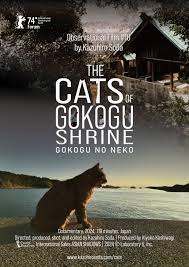
THE CATS OF GOKUGU SHRINE/ Gokogu no Neko
Japan, 2024, 119 minutes, Colour.
Directed by Kazuhiro Sôda.
Yes, many cats, especially in the early part of this film. We are in Japan, a small town which holds a popular Shinto shrine – the centre of prayer for the local people and for pilgrims. And it is something of a refuge for the wandering cats, Street cat’s (generally larger and will feed, plus some kittens – who are always cute!).
What is this film going to be. An explanation from the director. The director calls The Cats Of Gokogu Shrine an ‘observational film’ made using Soda’s own ‘Ten Commandments’, which includes no research, no scripts, no pre-set theme, no narration, no voiceovers, background music or preproduction research, and paying for his own production. These self-imposed rules are intended to minimise pre-conceptions and make way for unexpected discoveries.
So, first we discover the Cats. But then the action and the director’s interests move towards the inhabitants of the town, and quite some varying views about the Cats. There are some pleasing interviews with older people who have lived in Gokugo, have seen it prosper, have seen it settle. An old man who is quite articulate and good company as we listen to his reflections, meeting with a fisherman and a cheeky cat stealing his fish but also meeting with some tourists, especially a woman who can’t have a cat as a pet in her apartment block, feels overwhelmed by her work, and comes every couple of weeks or so to reunite with the cats and feel revived.
There is also a typhoon, the director himself involved, giving shelter to a ginger cat.
And then there is town Council and the director spending a lot of time at a meeting, perhaps too much time? enabling us to hear the various points of view about the prosperity or lack of prosperity of the town, and whether the cats are a blessing or whether they should be eliminated. There is an appeal this way to cat lovers as well as to those who would want to be rid of the cats. What about the mess the cats make around the town? More cats abandoned? Should there be a planned program for neutering? Or some terms for coexistence? And are they actually good for tourism?
A different excursion to Japan.
Bastion 36/ Squad 36
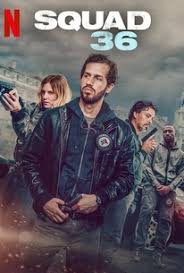
BASTION 36/SQUAD 36
France, 2025, 124 minutes, Colour.
Victor Belmondo, Tewfik Jalian, Yvan Attal Juliette Dol, Soufiane Guerrab.
Directed by Olivier Marchal.
Straightforward title, focus on a police squad, action, criminals, police corruption, cover-ups… In the French action style. Strong production values – but, the intricacies of the plot and characterisations sometimes defy credibility.
The film begins with quite a spectacular chase, the confrontation with the chief criminal and his defying of the officer who corners him. But, no arrest. The film then shows the officer participating in quite brutal bareknuckle fights, indicating skills he will have to use during the rest of the film. He has also been demoted. However, he is a dashing presence on screen at times, Victor Belmondo, and his surname gives an alert. He is a grandson of Jean-Paul Belmondo.
There are quite some complications in the squad, the passing on of information, big money deals, some greed, betrayals, and everything getting too much for one of the members of the squad who disappears from a mental institution.
Eventually, there are set ups, confrontations, betrayals, murders, the police authorities, including veteran Yvan Attal, who do not want any public scandals. The film is presented by Netflix – and is kind of Netflix streaming night in.
- The title, indications and expectations? French police, action, criminals, police corruption?
- The city settings, the streets, the chases, the confrontations, offices, homes, bare knuckle fighting? Atmosphere? The musical score?
- The initial chase, the role of the police, action spectacle? Antoine, his role, personality, the confrontation with Mahmoud? Backing off? No shootings? The setup for the future?
- The focus on Antoine, the authorities and their attitude, his membership of the squad, his violence, being stood down? The bareknuckle fight sequences? Time passing, the transfer, working with the other police?
- The situation, the criminal connections, drugs, money, deals, the corrupt police? Suspicions within the squad? Richard Esteves, his change of heart, in the institution, Antoine’s visit, seeing the former policeman getting his advice and information? Tracking down his fellow officers, finding Esteves?
- The other members, suspicions, actions, home sequences? Yet the violence, the killings, betrayals?
- Antoine, involvement, tracking down Esteves, with the officials, with Mahmoud and the confrontation?
- Popular entertainment, police action, police corruption, betrayals?
Dinosaur Project, The
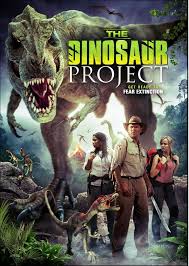
THE DINOSAUR PROJECT
UK, 2012, 83 minutes, Colour.
Richard Dillane, Matt Kane, Peter Brooke, Natasha Loring, Abena Ayivor, Stephen Jennings.
Directed by Sid Bennett.
Popular entertainment in 2012. The continued popularity, after Jurassic Park, speculations about dinosaurs and prehistoric creatures. The influence of The Blair Witch Project and the genre of “found footage”. There was also the memory of popular films of the 1970s, explorations, into the past, The Valley of Gwangi, Land that Time Forgot.
This film is very strong on the conventions of found footage, the characters provided with cameras, photographing the scenery, the creatures, their action, human reactions, and the characters talking to camera. Because it is found footage, the editing is in abrupt cuts from one piece to the other. And a lot of handheld camera, creating an atmosphere of exploration.
The presupposition of the story is an organisation in England, Cryptozoological, and television news about the sighting of a creature in Africa. An expedition is organised, a local guide, female, camera expert, of the members with one of them turning out to have violent rivalry, and the leader, very experienced, with encounters with his 15-year-old son who stows away for the expedition, and is instrumental in the crash of a helicopter, and some blame and acrimony from the violent member of the expedition, wanting to kill him in several confrontations.
The plot is conventional enough, the group lost in a kind of lost world, moving through the jungle, encountering the creatures, filming, hiding, menace and attacks. The 15-year-old, Luke, proves adept at science and technology, putting the camera on one of the creatures, establishing a relationship, feeding, spat upon (which is important eventually because it means that the other creatures accept him and not in the violent man who is about to kill him).
The film was shot in South Africa, vivid scenery and locations. There is some attention given to the characterisation but, mostly, to the leader and his son, the female doctor dying quickly into the action, the female guide becoming more hostile. The CGI of the animals, the creatures, is quite effective.
And, at the end, the authorities find the footage and begin to watch it.
Audiences interested in in searches for prehistoric creatures will find it intriguing in its way, but it is a short, modest, production
Spit
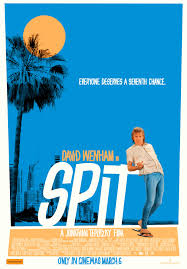
SPIT
Australia, 2025, 102 minutes, Colour.
David Wenham, Arlo Green, David Field, Gary Sweet, Lewis Fitz-gerald, Maude Davey, David Roberts, Helen Thomson, Andrea Moore, Pallavi Sharda.
Directed by Jonathan Teplitzky.
In 2002, there was an award-winning comedy-drama, Getting’ Square, set on the Gold Coast, the story of drugs, corrupt police, investigations – and the roguish character, John Francis Spitieri, whom everybody called Spit, an addict but reforming, thongs, old crumpled clothes, providing a great deal of comedy along the way.
It is not necessary for audiences to have seen Getting’ Square to enjoy this follow-up, focusing on Spit. In fact, the film has a lot of things going for it, indeed more than a lot of things. Writer, Chris Nyst, is a criminal lawyer and knows the characters that he has created for the original and for Spit. David Wenham has noted that he is an ambassador for Kings Cross’s Wayside Chapel and is very much aware of many variations on Spit. Both Nyst and Wenham won AFI awards back then and are candidates for 2025, an even better script, and Wenham having lived with this character over a long time.
The screenplay is alive, vivid life through the characters. We laugh out loud then, only minutes later, some moments of deep humane pathos on serious themes, then laughs again and throughout some serious and violent sequences connected with the thugs and the law. As mentioned, these characters were in the original and there are some references back, some clips from the original – and, with such admiration for the court scene in the original, another court scene which is as good.
But, this time, Spit returning to Queensland on a fake passport and detained by the authorities, is more of a larrikin, an Aussie larrikin rather than a rogue. His face is now weatherbeaten. And he has his ambling gate, the thongs, the jeans, weary on the surface but pretty shrewd when he wants to be – and this is especially the case in the inner unexpected solution to his problems.
He is still pursued by the drug chief and the corrupt police (snarling Gary Sweet and David Field). But, on landing he is sent to a detention centre, encountering the refugees, listening to their stories. His dealing with them, teaching English, is very enjoyable Australian comedy, especially in dealing with Australia’s and the world’s hyper- abundant F-word. Spit sees it not as an swear word but as an emphasiser (though he cannot quite pronounce that correctly). His class illustrating its variety of emphases is quite hilarious (even for those who do not yet use it) and is followed up with many variations on it throughout the film.
But, for pathos there is the story of Spit’s sister and their separation, foster homes, reunited, her son, her illness and the demands on Spit’s affection.
One of the clever aspects of the screenplay is the frequency of quips, word misunderstandings that provide a lot of wit. And there is the courtroom, David Roberts providing a prosecutor straight man to Spit’s mischievousness, and all about reading glasses. David Wenham shows how adept he is. We know he does serious well, but he really embodies the comic Spit.
And he plays alongside a number of Australian character actors, especially with New Zealander, Arlo Green, as a sympathetic Syrian refugee.
Jonathan Teplitzky directed Getting’ Square (and also directed Wenham in Better than Sex) and the excellent, The Railway Man.
This reviewer would enjoy watching it again and certainly laughing with it.
- The popularity of get in Square? A criminal world in Queensland? The quality of the screenplay and awards, David Wenham as spit and his awards? Welcoming him back with his own film?
- The Queensland settings, airports, detention centres, restaurants, funeral parlours, police precincts, the courts, gardens, the beach and the sea, hospitals? Atmosphere? The musical score?
- David Wenham’s portrait of Spit? His appearance, clothes, thongs, swagger? His vocabulary? The Australian larrikin, drugs in the past, criminal connections, reform, time in the UK, the Falls passport, arrival, behaviour at the airport, in the detention centre? Criminals discovering his being alive? The law and courts discovering that he was alive?
- His background, story of his childhood, parents, his sister, the fire, foster care? The reuniting, his sister, death, her son, the bonding with Spit, her illness, death? His responsibility for the boy? Talking to the authorities, the future for him and the boy?
- In the detention centre, Spit at something of a conman, taking the classes, listening to the stories of the refugees, giving them Australian names, vocabulary, the class on the use of the F word? Meeting with Jihad and his Syrian background story? Friendship?
- Chika, His role in the past, drugs, the violence, his thugs, connections? Wanting to get Spit, sending the thugs, Spit in the confrontations, escaping? De Viers, police, corruption, his assistant, manipulation, contact with Chika? Plots, arrests, abducting Spit, holding out the window, and that you are later revelation for the solution? Spit and his escapes, disguised as the woman, running through the suburbs?
- Jihad, out of detention, skill with flowers, his relatives, the welcome, the parties, at the funeral parlour, helping Spit, becoming more involved?
- Spit, going to the funeral parlour, memories of the first film, the wife, the money, setting up the funeral parlour with the money, Spit and his share in the ownership? Their involvement in saving Spit?
- Court, the police, tough attitudes towards spit, towards those in the detention centre? Hiring the lawyer, her style, pushy, ambitious, self promoting? In the court? Nile to, the past, wanting to get Spit, the prosecution in the court, Spit and his behaviour, language, the comedy with the glasses and is eventually stealing them in Tool losing them are not able to read the documents?
- The police and the court, Chika and his pressure on the criminal, the criminal turning round, killing Chika?
- The final Revelation, Spit and his writing on the wall, proving that he was abducted, vindicated?
- The 21st century Australian comedy, larrikin style?
Dance First

DANCE FIRST
UK, 2023, 100 minutes, Colour.
Gabriel Byrne, Fionn O'Shea, Sandrine Bonnaire, Lisa Dwyer Hogg, Leonie Grainne, Aidan Gillen, Maxine Peake, Bronagh Gallagher, Robert Aramayo.
Directed by James Marsh.
Mention of Irish writer, resident for decades in France, Samuel Beckett, usually leads to the naming of Waiting for Godot. And there is reference to this throughout the film although the title quotation, here attributed to Beckett talking to a student, has reference to Godot. The title, coming later in the film, emphasises experience first, then reflection.
The film has been directed by James Marsh, noted for documentaries like Man on Wire as well as feature films like Theory of Everything.
The film is also a tour de force for Irish actor, Gabriel Byrne, portraying Beckett throughout his adult life but also the device of having him also appear as his inner self, continued discussions, challenges, greater understanding. The film opens with his being awarded the Nobel Prize for Literature, his judge at a catastrophe, his refusal to the speech – and a contrived sequence where he goes on stage, crashes through, escapes and begins the dialogue with his inner self.
This is a portrait of Beckett rather than a biography. The chapters are headed by the names of people who are significant Beckett’s life. In the early part of the film, Beckett as portrayed by the on O’Shea, a very serious bespectacled young man, ambitious writer, dominated by his sometimes terrifying mother, leaving Ireland as soon as possible, seeking out James Joyce in Paris (a very fine performance from Aidan Gillen, different from his other roles), part of his household, Nora Joyce wanting him to marry their daughter, Lucia, who has mental problems.
Beckett is very serious, wanting to hear every word from Joyce, reticent, having to take Lucia dancing, her thinking she was engaged, the terrible track tantrum when she learns the truth, throwing a charity mother, and her spending decades in an institution.
The significance influence on his life was Suzanne, his partner for many years, sharing the times during World War II when neutral Irish picket could stay in France, but join the resistance, their activities, and years of working in the fields to survive. But, literary agent, Barbara, Maxine Peake, admires Beckett, praising, begins a liaison with him.
The film moves towards Beckett success in theatre, Suzanne and her continued challenge to Beckett, the Nobel Prize.
Beckett certainly has his place in world literature – perhaps this film will raise further interest in him and his work.
- The reputation of Samuel Becket, writer, novelist, playwright, Irish background, living and working in France, the Nobel Prize?
- The structure of this portrait of Becket? The highlighting of significant characters for each chapter? 100 minute portrait, sketches of key events in Becket’s life, the influences, aspects of his career, though not to the forefront?
- The meaning of the title, experience before reflection, dancing first then later thinking?
- Gabriel Byrne, his portrait of Becket, and the dialogue with his inner self? This continuing throughout the film, Becket with insights into himself, the significance of self-reflection?
- Becket’s Irish background, his family, the significance of his mother, her strong character, dominating, unpleasant, her controlling of the little boy? The continued controlling as he grew up, her expectations and demands? Her relationship with her husband? His being a fond father, softer with Becket, his dying? Liberating Becket to move away from home?
- Becket, in his teens, early adulthood, bespectacled, serious, writing, the interactions with his mother?
- Becket going to France, the importance of James Joyce, Joyce’s reputation, listening to Becket, Becket’s admiration, very serious? Inviting him to the house? Nora Joyce, a character, running the household, relationship with her husband? Welcoming Becket? His seriousness, ignoring conversation, wanting to listen to Joyce? Joyce, his character, tolerance?
- The influence of Lucia, her mental condition, emotions, at the table, her mother trying to foster a relationship with Becket, his being unwilling? Taking her dancing as a condition of coming back? The dancing, her exuberance, his reticence? Her expectations, imagining engagement? Her mother encouraging? Joyce benign? Coming to a head, the many outings, his refusal, Lucia’s tantrum, throwing the chair? Her going to an institution? Her being there for decades? And the effect on Becket throughout the time?
- Suzanne, meeting Becket, the attraction, her admiration and encouragement? Helping Becket to understand Joyce, Joyce and his distancing himself? The meeting with Alfie, their translation, he begins Wake, their contribution, the launch, the speeches?
- The 30s passing, the outbreak of the war, Becket Irish and therefore neutral, staying in France, Alfie and the Resistance, Becket wanting to join, going with Alfie, with Suzanne, the years of the war, working in the fields, the effect?
- The aftermath, Becket and his writing, becoming more famous, relationship with Suzanne, Barbara arriving, her admiration, her personality, her influence, the relationship with Becket, over the years, the performance of the play, people’s admiration, that he was a genius, Suzanne and her negative reaction is, the encounter with Barbara? The continued relationship, tension is?
- Becket’s output, success, theatre, the Nobel Prize, catastrophe, his not giving a speech?
- Into the 80s, the relationship with Suzanne, her illness, his care for her, her death? Barbara and her presence? Becket into his 80s?
- The outline of Becket’s life and influences, indications of his career and acclaim? References to waiting for Godot?
- The importance of the continued conversation between Becket and his inner self, in the aftermath of the Nobel Prize, the discussions about the characters in the past, his attitudes, his career, success on not, his self-image? And the title of the film, coming later in the film?
- The film fostering admiration for Becket and his literary career, fostering interest in study of Becket?
Under the Stars of Paris/ Sous les étoiles de Paris
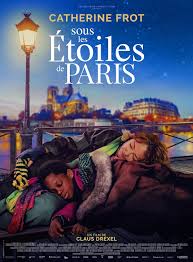
UNDER THE STARS OF PARIS / Sous les étoiles de Paris
France, 2020, 86 minutes, Colour.
Catherine Frot, Mahamadou Yaffa.
Directed by Claus Drexel.
A brief French film which is very touching. It focuses on life in Paris, especially for the poor and homeless. But it also focuses on refugee issues, detention, deporting.
The photography of Paris is visit, the river, the bridges, the streets, the life of the poor. There is some travel sequences, airport scenes.
The initial focus of attention is on Christine, an older homeless woman, played by veteran Catherine Frost. The early scenes show her life, age, clothes, walking the streets, collecting food, not interacting with people, her hideout for accommodation. Then the film introduces a young boy, played by Mahamadou Yaffa, who has since it appeared in some television series. He is from Africa, does not speak English, has lost his mother, has a document identifying her information that she is to be deported.
The boy follows Christine, she helping him, but wanting to be rid of him, his continual following her. The film shows the growing bond, Christine’s motherly tendencies, the boys need for some kind of physical support, food, emotional support, and the search for his mother. The scenes of the two bonding are quite moving.
The film shows the plight of refugees in France, deportation, the effect on people, on families, a challenge to refugee and deportation policy.
- Brief film, human impact?
- The title, the Paris settings, the river, bridges, the neighbourhoods, the streets, poverty, centres for the poor and hungry, the detention centre, the airport? The musical score?
- The portrait of Christine, her age, physical condition, poverty, the way she walked, her clothes, communication, her hideout, the food, the magazine, the worker and his interactions? Relating to people, alone?
- The portrait of Suli, Eritrea, his age, background, unable to speak in French, his mother, the document, detention, separated from his mother? Alone, lost, hungry? The encounter with Christine, helping, is seeing her as a mother, purging him off, his continuing to follow, the gradual bonding between them, travelling together, the information about the detention centre, the visit, getting more information, the airport, the further travels, in the airport, hiding, intervention Patrick, his sympathy, hiding them? The seeming frustration, the final glimpse, Patrick helping, the mother, reconciled with her son?
- The effect on Christine, some meaning in her life joy, surrogate mother? The experience of the boy, his devotion to Christine, we Sulli and the future memories?
Acknowledging Patrick Austin MSC, 85, March 10th
Acknowledging Patrick Austin MSC, 85, March 10th

His first Profession, February 26th, 1960. Studies at Canberra and Croydon monasteries. He was ordained priest on 14th December 1968.
In his fifty six years plus of priesthood, Pat has served in a variety of ministries, in colleges, including Monivae, in parishes, including Park Orchards/Warrendyte, and time in both the Northern Territory and Papua New Guinea. For many years he supplied in the NSW parish of Balranald in the large Wilcannia-Forbes Diocese.
More lately he has been stationed at Kensington Monastery.
International Women's Day (8 March), Laity of the Chevalier Family
International Women's Day (8 March), Laity of the Chevalier Family
Kerrie Wehbe
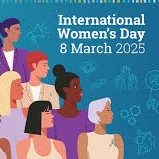
Photo, Government of WA
At the Assembly of the Synod on Synodality in Rome in October 2023, the participants recognized that “in Christ, women and men are clothed with the same baptismal dignity (Gal 3:28) and receive equally the variety of gifts of the Spirit.” This Synod, and our recent Synod in Australia, said it was urgent to ensure that women can participate in decision-making processes and assume roles of responsibility in pastoral care and ministry.
Pope Francis reinforces this sentiment: “If we take to heart the importance of the future, if we dream of a future of peace, we need to give space to women. I like to think that if women could enjoy full equality of opportunity, they could contribute substantially to the necessary change towards a world of peace, inclusion, solidarity and integral sustainability.” (2023)

Members of the Chevalier Family have a very proud history as part of a force for change for the betterment of women and girls around the world through a wide variety of ministries, especially education, which is a foundational cornerstone of equity for women and girls. Taking Mary as a model, the MSC, OLSH Sisters and their partners-in-mission have always believed that women sow the seeds of the civilization of love with their high capacity for personal self-giving.
Prayer
God, whose love and goodness gather us in: we pray for women all over the world, especially those challenged by poverty and other injustice. Stir us to know women’s dignity, quieten us to listen to women’s voices. Awaken us to see women’s realities. Strengthen us to stand for women’s rights. Fill us with hope to make a better future together. Amen. (Caritas Australia)
Our Lady of the Sacred Heart, entrusted with the formation of Jesus’ humanity, the first disciple of Jesus, and the first witness to his love, pray for us.
From the Media Blog of the Australian Bishops Conference:
International Women’s Day on March 8 is a time to take action to ensure women’s safety, inclusion and leadership.
Bishop Michael Morrissey, the Australian Catholic Bishops Conference’s delegate for women, welcomed this year’s International Women’s Day theme, “Accelerate Action”.
“The voice and leadership of women is critical to the Church’s future and integral to our journey together, as the final document of the Synod on Synodality reminds us,” Bishop Morrissey said.
“The Australian Plenary Council and the Synod highlighted the need to improve our efforts to invite and make space for women’s baptismal call of co-responsibility.

